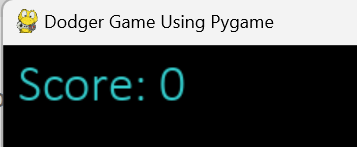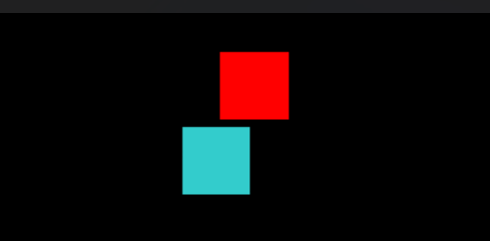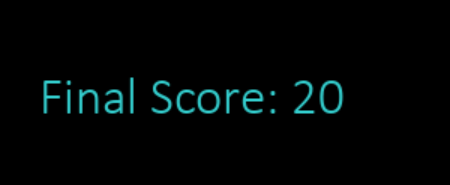Dodger Game using Pygame in Python
Last Updated :
23 Jul, 2025
A Dodger game is a type of game in which a player has access to control an object or any character to dodge (to avoid) upcoming obstacles and earn points according to the number of items dodged if the player is not able to dodge the object the game will be over and final score will be displayed in the console. After certain points or times the speed of the objects to be dodged increases which makes it harder and harder to score more points. The player can control the movement through some input from some input devices, it can a keyboard, a joystick, a game controller, etc..
Building a Dodger Game using Pygame
Installation of the required Python library
First, we need to install the Pygame library in the system, to install use the following command and run the command in the command prompt (for the Windows operating system).
pip install pygame
 After Executing the command.
After Executing the command. Importing the library to use it inside the Python code
After Importing we can use the pygame properties.
Python
import pygame
import random
Declaration and initialization of variables
The Screen Height , Width is declared along with come colors and the frame rates.
Python
pygame.init()
display_width = 880
display_height = 600
color1 = (51,204,204)
color2 = (0,0,0)
color3 = (255, 0, 0)
display = pygame.display.set_mode((display_width, display_height))
pygame.display.set_caption("Dodger Game Using Pygame")
frame_rate = pygame.time.Clock()pygame.init()
display_width = 880
display_height = 600
color1 = (51,204,204)
color2 = (0,0,0)
color3 = (255, 0, 0)
display = pygame.display.set_mode((display_width, display_height))
pygame.display.set_caption("Dodger Game Using Pygame")
frame_rate = pygame.time.Clock()
Declaration of the players details and the objects that need to be dodged
The variables are created to declare the size of the player , the movement ,the speed and similarly for the dodged object.
Python
gamer_detail = 45
gamer_movement = [display_width // 2, display_height - 2 * gamer_detail]
gamer_speed = 15
to_dodge_detail = 45
to_dodge_position1 = [random.randint(0, display_width - to_dodge_detail), 0]
to_dodge_position2 = [random.randint(0, display_width - to_dodge_detail), 0]
to_dodge_speed = 10
points = 0
font = pygame.font.SysFont("calibri", 35)
Deceleration of the the function
This function basically checks for the collision between the player and the random object which need to be dodged.
Python
def check_for_colision(gamer_movement, enemy_pos):
p_x, p_y = gamer_movement
e_x, e_y = enemy_pos
if (e_x < p_x < e_x + to_dodge_detail or e_x < p_x + gamer_detail < e_x + to_dodge_detail) and \
(e_y < p_y < e_y + to_dodge_detail or e_y < p_y + gamer_detail < e_y + to_dodge_detail):
return True
return False
Wrapping the code
The code is iterated by using a while loop and condition that until the condition for game over become false this will work and update the score values and increases the speed of the objects after certain points and it will display the final score if the game is over (player could not able to dodge).
Python
game_over = False
while not game_over:
for event in pygame.event.get():
if event.type == pygame.QUIT:
game_over = True
keys = pygame.key.get_pressed()
if keys[pygame.K_LEFT]:
gamer_movement[0] -= gamer_speed
if keys[pygame.K_RIGHT]:
gamer_movement[0] += gamer_speed
if gamer_movement[0] < 0:
gamer_movement[0] = 0
elif gamer_movement[0] > display_width - gamer_detail:
gamer_movement[0] = display_width - gamer_detail
display.fill(color2)
to_dodge_position1[1] += to_dodge_speed
to_dodge_position2[1] += to_dodge_speed
if to_dodge_position1[1] > display_height:
to_dodge_position1 = [random.randint(0, display_width - to_dodge_detail), 0]
points += 1
to_dodge_speed += 0.5
if to_dodge_position2[1] > display_height:
to_dodge_position2 = [random.randint(0, display_width - to_dodge_detail), 0]
points += 1
to_dodge_speed += 0.5
if check_for_colision(gamer_movement, to_dodge_position1) or check_for_colision(gamer_movement,
to_dodge_position2):
game_over = True
break
pygame.draw.rect(display, color3, (to_dodge_position1[0], to_dodge_position1[1],
to_dodge_detail, to_dodge_detail))
pygame.draw.rect(display, color3, (to_dodge_position2[0], to_dodge_position2[1],
to_dodge_detail, to_dodge_detail))
pygame.draw.rect(display, color1, (gamer_movement[0], gamer_movement[1],
gamer_detail, gamer_detail))
score_text = font.render("Score: {}".format(points), True, color1)
display.blit(score_text, (10, 10))
pygame.display.update()
frame_rate.tick(30)
display.fill(color2)
game_over_text = font.render("Final Score: {}".format(points), True, color1)
display.blit(game_over_text, (display_width // 2 - 200, display_height // 2 - 20))
pygame.display.update()
pygame.time.wait(3000)
pygame.quit()
Complete Code
Python
import pygame
import random
pygame.init()
display_width = 880
display_height = 600
color1 = (51, 204, 204)
color2 = (0, 0, 0)
color3 = (255, 0, 0)
display = pygame.display.set_mode((display_width, display_height))
pygame.display.set_caption("Dodger Game Using Pygame")
frame_rate = pygame.time.Clock()
gamer_detail = 45
gamer_movement = [display_width // 2, display_height - 2 * gamer_detail]
gamer_speed = 15
to_dodge_detail = 45
to_dodge_position1 = [random.randint(0, display_width - to_dodge_detail), 0]
to_dodge_position2 = [random.randint(0, display_width - to_dodge_detail), 0]
to_dodge_speed = 10
points = 0
font = pygame.font.SysFont("calibri", 35)
def check_for_colision(gamer_movement, enemy_pos):
p_x, p_y = gamer_movement
e_x, e_y = enemy_pos
if (e_x < p_x < e_x + to_dodge_detail or e_x < p_x + gamer_detail < e_x + to_dodge_detail) and \
(e_y < p_y < e_y + to_dodge_detail or e_y < p_y + gamer_detail < e_y + to_dodge_detail):
return True
return False
game_over = False
while not game_over:
for event in pygame.event.get():
if event.type == pygame.QUIT:
game_over = True
keys = pygame.key.get_pressed()
if keys[pygame.K_LEFT]:
gamer_movement[0] -= gamer_speed
if keys[pygame.K_RIGHT]:
gamer_movement[0] += gamer_speed
if gamer_movement[0] < 0:
gamer_movement[0] = 0
elif gamer_movement[0] > display_width - gamer_detail:
gamer_movement[0] = display_width - gamer_detail
display.fill(color2)
to_dodge_position1[1] += to_dodge_speed
to_dodge_position2[1] += to_dodge_speed
if to_dodge_position1[1] > display_height:
to_dodge_position1 = [random.randint(
0, display_width - to_dodge_detail), 0]
points += 1
to_dodge_speed += 0.5
if to_dodge_position2[1] > display_height:
to_dodge_position2 = [random.randint(
0, display_width - to_dodge_detail), 0]
points += 1
to_dodge_speed += 0.5
if check_for_colision(gamer_movement, to_dodge_position1) or check_for_colision(gamer_movement,
to_dodge_position2):
game_over = True
break
pygame.draw.rect(
display, color3, (to_dodge_position1[0], to_dodge_position1[1],
to_dodge_detail, to_dodge_detail))
pygame.draw.rect(
display, color3, (to_dodge_position2[0], to_dodge_position2[1],
to_dodge_detail, to_dodge_detail))
pygame.draw.rect(
display, color1, (gamer_movement[0], gamer_movement[1],
gamer_detail, gamer_detail))
score_text = font.render("Score: {}".format(points), True, color1)
display.blit(score_text, (10, 10))
pygame.display.update()
frame_rate.tick(30)
display.fill(color2)
game_over_text = font.render("Final Score: {}".format(points), True, color1)
display.blit(game_over_text, (display_width //
2 - 200, display_height // 2 - 20))
pygame.display.update()
pygame.time.wait(3000)
pygame.quit()
NOTE: User can customize the code according to the choice and can add more features to the code depending upon the requirement.
Output
 Initial score
Initial score Here the blue color indicate the player and the red color is the object
Here the blue color indicate the player and the red color is the object When the game is the over the final score is displayed.
When the game is the over the final score is displayed.
